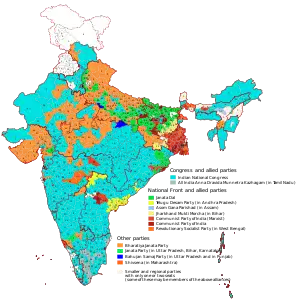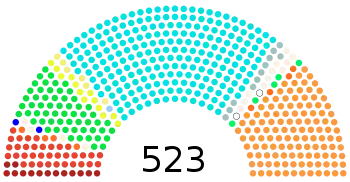| |||||||||||||||||||||||||||||||||||||||||||||||||||||||||||
534 of the 543 seats in the Lok Sabha 268 seats needed for a majority | |||||||||||||||||||||||||||||||||||||||||||||||||||||||||||
|---|---|---|---|---|---|---|---|---|---|---|---|---|---|---|---|---|---|---|---|---|---|---|---|---|---|---|---|---|---|---|---|---|---|---|---|---|---|---|---|---|---|---|---|---|---|---|---|---|---|---|---|---|---|---|---|---|---|---|---|
| Registered | 498,363,801 | ||||||||||||||||||||||||||||||||||||||||||||||||||||||||||
| Turnout | 56.73% ( | ||||||||||||||||||||||||||||||||||||||||||||||||||||||||||
| |||||||||||||||||||||||||||||||||||||||||||||||||||||||||||
 | |||||||||||||||||||||||||||||||||||||||||||||||||||||||||||
| |||||||||||||||||||||||||||||||||||||||||||||||||||||||||||
General elections were held in India on 20 May, 12 June and 15 June 1991 to elect the members of the 10th Lok Sabha, although they were delayed until 19 February 1992 in Punjab.
No party could muster a majority in the Lok Sabha, resulting in the Indian National Congress forming a minority government under new Prime Minister P. V. Narasimha Rao with the support of other parties.The government survived 28 July 1993 no confidence vote in controversial circumstances by engineering defections from the Janata Dal and the Jharkhand Mukti Morcha.[2][3]
Elections were not held for the six seats allocated to Jammu and Kashmir, nor for two seats in Bihar and one in Uttar Pradesh. Voter turnout was the lowest to date in an Indian general election.[4]
Background
The 1991 elections were held as the previous Lok Sabha, with Chandra Sekhar at its helm had been dissolved just 16 months after government formation. Over 500 million eligible voters were once again given the chance to elect their government.[5] The elections were held in a polarised environment and are also referred to as the 'Mandal-Mandir' elections after the two most important poll issues, the Mandal Commission fallout and the Ram Janmabhoomi-Babri Masjid issue.
Mandal-Mandir Issue
While the Mandal Commission report implemented by the VP Singh government gave 27 per cent reservation to the Other Backward Castes (OBCs) in government jobs, it led to widespread violence and protests across the country, with many students in and around Delhi even setting themselves on fire. Mandir represented the hallmark of this election, where there was a debate over the disputed Babri Masjid structure at Ayodhya, which the Bharatiya Janata Party was using as its major election manifesto.
The Mandir issue led to numerous riots in many parts of the country and the electorate was polarised on caste and religious lines. With the National Front falling apart, the Congress managed to make the most of the polarisation, by getting the most seats and forming a minority government.[6]
Rajiv Gandhi Assassination
A day after the first round of polling took place on 20 May, former prime minister Rajiv Gandhi was assassinated while campaigning for Margatham Chandrasekar at Sriperembudur. The remaining election days were postponed until mid-June and voting finally took place on 12 and 15 June. Voting was the lowest ever in parliamentary elections with just 53 per cent of the electorate exercising their right to vote.
Since the assassination took place after first phase of polling in 211 of 534 constituencies and the balance constituencies went to polls after the assassination, the 1991 results varied greatly between phases.[7] Congress was almost wiped out in the first phase, and rode a massive sympathy wave to sweep the second phase.[5] The end result was a Congress-led minority government led by P. V. Narasimha Rao, who had previously announced his retirement from politics. While P.V. Narsimha Rao had not contested in the election, he contested in a by-election in Nandyal which he won by a record five lakh votes.
Jammu & Kashmir, Punjab
76 to 126 people were shot dead during campaign on 17 June 1991 in two attacks by gunmen in Punjab, an area racked by separatist violence. Police reports said the killings, on separate trains, were carried out by Sikh militants.[8] No elections were held in Jammu and Kashmir and Punjab, a total of 19 Lok Sabha seats.[9] Elections were held in Punjab on 19 February 1992,[10] where INC won 12 out of 13 seats,[11] thereby taking their tally in the Lok Sabha up from 232 to 244.
| This article is part of a series on the |
| Politics of India |
|---|
 |
|
|
Results
 | ||||
|---|---|---|---|---|
| Party | Votes | % | Seats | |
| Indian National Congress | 99,799,403 | 36.26 | 232 | |
| Bharatiya Janata Party | 55,345,075 | 20.11 | 120 | |
| Janata Dal | 32,589,180 | 11.84 | 59 | |
| Communist Party of India (Marxist) | 16,954,797 | 6.16 | 35 | |
| Janata Party | 9,267,096 | 3.37 | 5 | |
| Telugu Desam Party | 8,223,271 | 2.99 | 13 | |
| Communist Party of India | 6,851,114 | 2.49 | 14 | |
| Dravida Munnetra Kazhagam | 5,741,910 | 2.09 | 0 | |
| All India Anna Dravida Munnetra Kazhagam | 4,470,542 | 1.62 | 11 | |
| Bahujan Samaj Party | 4,420,719 | 1.61 | 2 | |
| Shiv Sena | 2,208,712 | 0.80 | 4 | |
| Revolutionary Socialist Party | 1,749,730 | 0.64 | 4 | |
| Asom Gana Parishad | 1,489,898 | 0.54 | 1 | |
| Jharkhand Mukti Morcha | 1,481,900 | 0.54 | 6 | |
| Janata Dal (Gujarat) | 1,399,702 | 0.51 | 1 | |
| Pattali Makkal Katchi | 1,283,065 | 0.47 | 0 | |
| All India Forward Bloc | 1,145,015 | 0.42 | 3 | |
| Indian Congress (Socialist) – Sarat Chandra Sinha | 982,954 | 0.36 | 1 | |
| Indian Union Muslim League | 845,418 | 0.31 | 2 | |
| Indian Peoples Front | 644,891 | 0.23 | 0 | |
| Natun Asom Gana Parishad | 494,628 | 0.18 | 0 | |
| Karnataka Rajya Ryota Sangha | 490,275 | 0.18 | 0 | |
| Doordarshi Party | 466,869 | 0.17 | 0 | |
| All India Majlis-e-Ittehadul Muslimeen | 456,900 | 0.17 | 1 | |
| Kerala Congress (M) | 384,255 | 0.14 | 1 | |
| Jharkhand Party | 350,699 | 0.13 | 0 | |
| Haryana Vikas Party | 331,794 | 0.12 | 1 | |
| Nagaland People's Council | 328,015 | 0.12 | 1 | |
| Bharatiya Republican Paksha | 327,941 | 0.12 | 0 | |
| Kerala Congress | 319,933 | 0.12 | 0 | |
| Peasants and Workers Party of India | 295,402 | 0.11 | 0 | |
| United Minorities Front, Assam | 206,737 | 0.08 | 0 | |
| Lokdal | 173,884 | 0.06 | 0 | |
| Marxist Co-ordination Committee | 171,767 | 0.06 | 0 | |
| United Reservation Movement Council of Assam | 170,376 | 0.06 | 0 | |
| Manipur Peoples Party | 169,692 | 0.06 | 1 | |
| Autonomous State Demand Committee | 139,785 | 0.05 | 1 | |
| Sanjukta Loka Parishad | 125,738 | 0.05 | 0 | |
| Sikkim Sangram Parishad | 106,247 | 0.04 | 1 | |
| Republican Party of India (Khobragade) | 91,557 | 0.03 | 0 | |
| Shiromani Akali Dal (Simaranjit Singh Mann) | 88,084 | 0.03 | 0 | |
| Plain Tribals Council of Assam | 87,387 | 0.03 | 0 | |
| Mizo National Front | 82,019 | 0.03 | 0 | |
| Sarv Jati Janata Parishad | 70,368 | 0.03 | 0 | |
| Akhil Bharat Hindu Mahasabha | 67,495 | 0.02 | 0 | |
| Maharashtrawadi Gomantak Party | 64,752 | 0.02 | 0 | |
| Tharasu Makkal Mandram | 55,165 | 0.02 | 0 | |
| Uttarakhand Kranti Dal | 47,369 | 0.02 | 0 | |
| Marxist Communist Party of India (S.S. Srivastava) | 43,085 | 0.02 | 0 | |
| Bharatiya Krishi Udyog Sangh | 42,504 | 0.02 | 0 | |
| Jan Parishad | 37,725 | 0.01 | 0 | |
| Republican Party of India | 36,541 | 0.01 | 0 | |
| Amra Bangali | 35,186 | 0.01 | 0 | |
| Indian Union Muslim League (IML) | 31,387 | 0.01 | 0 | |
| Sampooran Kranti Das | 29,647 | 0.01 | 0 | |
| Akhil Bharatiya Manav Seva Das | 28,528 | 0.01 | 0 | |
| Uttar Pradesh Republican Party | 28,379 | 0.01 | 0 | |
| Yuva Vikas Party | 28,159 | 0.01 | 0 | |
| Communist Party of India (Marxist–Leninist) | 27,730 | 0.01 | 0 | |
| Jawan Kisan Mazdoor Party | 23,929 | 0.01 | 0 | |
| Proutist Bloc of India | 22,734 | 0.01 | 0 | |
| Soshit Samaj Dal | 19,925 | 0.01 | 0 | |
| Akhil Bharatiya Jansangh | 19,243 | 0.01 | 0 | |
| Orissa Vikas Parishad | 15,893 | 0.01 | 0 | |
| Hul Jharkhand Party | 15,406 | 0.01 | 0 | |
| Socialist Party of India (Lohia) | 12,928 | 0.00 | 0 | |
| Akhil Bharatiya Hindustani Krantikari Samajwadi Party | 12,820 | 0.00 | 0 | |
| Dalit Panthers Party | 11,967 | 0.00 | 0 | |
| Bharatiya Loktantrik Mazdoor Dal | 10,837 | 0.00 | 0 | |
| Akhil Bharatiya Revolutionary Samaj Dal | 8,825 | 0.00 | 0 | |
| Akhil Bhartiya Shivsena-Rashtrawadi | 8,810 | 0.00 | 0 | |
| Asom Jatiyatabadi Dal | 8,519 | 0.00 | 0 | |
| Ambedkar Makkal Iyakkam | 8,252 | 0.00 | 0 | |
| Asom Jatiya Parishad | 8,047 | 0.00 | 0 | |
| Socialist Party (Ramakant Pandey) | 7,104 | 0.00 | 0 | |
| Akhil Bharatiya Pichhadavarg Party | 6,897 | 0.00 | 0 | |
| All India Dalit Muslim Minorities Suraksha Mahasangh | 5,888 | 0.00 | 0 | |
| Vidarbha Praja Party | 5,597 | 0.00 | 0 | |
| Akhil Bharatiya Gram Parishad | 5,521 | 0.00 | 0 | |
| Akhil Bhartiya Dharmnirpeksh Dal | 5,436 | 0.00 | 0 | |
| Hindu Swaraj Sangathan | 5,325 | 0.00 | 0 | |
| Republican Presidium Party of India | 4,967 | 0.00 | 0 | |
| Surajya Party | 4,705 | 0.00 | 0 | |
| Sarvodaya Party | 4,642 | 0.00 | 0 | |
| Janata Dal (Samajwadi) | 4,548 | 0.00 | 0 | |
| Deseeya Karshaka Party | 4,508 | 0.00 | 0 | |
| Gondwana Party | 3,605 | 0.00 | 0 | |
| Azad Hind Fauz (Rajkiya) | 3,543 | 0.00 | 0 | |
| Samdarshi Party | 2,921 | 0.00 | 0 | |
| Lok Party | 2,873 | 0.00 | 0 | |
| Socialist League of India | 2,852 | 0.00 | 0 | |
| All India Urdu Morcha | 2,655 | 0.00 | 0 | |
| Akhil Bhartiya Ramrajya Parishad (Vasudev Shastri Atul) | 2,519 | 0.00 | 0 | |
| All India Kisan Mazdoor Sabha | 2,311 | 0.00 | 0 | |
| Pondicherry Mannila Makkal Munnani | 2,259 | 0.00 | 0 | |
| Pandav Dal | 2,213 | 0.00 | 0 | |
| Internationalist Democratic Party | 2,078 | 0.00 | 0 | |
| Gomant Lok Party | 1,983 | 0.00 | 0 | |
| Akhil Bharatiya Desh Bhakt Morcha | 1,792 | 0.00 | 0 | |
| Workers Party of India | 1,781 | 0.00 | 0 | |
| Nationalist Party | 1,768 | 0.00 | 0 | |
| Marx Engles Leninist Commune Health Association | 1,692 | 0.00 | 0 | |
| Nagaland Peoples Party | 1,572 | 0.00 | 0 | |
| Adarsh Lok Dal | 1,544 | 0.00 | 0 | |
| Desh Bhakt Party | 1,521 | 0.00 | 0 | |
| Akhil Bharatiya Bharat Desham Party | 1,466 | 0.00 | 0 | |
| Republican Party of India (Kamble) | 1,300 | 0.00 | 0 | |
| Akhil Bharatiya Janhit Jagrati Party | 1,245 | 0.00 | 0 | |
| Mukt Bharat | 1,191 | 0.00 | 0 | |
| Rashtriya Krantikari Dal | 1,125 | 0.00 | 0 | |
| Sampooran Rashtriya Sena | 1,040 | 0.00 | 0 | |
| Gramma Munnetra Kazhagam | 1,030 | 0.00 | 0 | |
| Navbharat Party | 787 | 0.00 | 0 | |
| Labour Party of India (V.V. Prasad) | 684 | 0.00 | 0 | |
| Thayaga Marumalrchi Kazhagam | 665 | 0.00 | 0 | |
| Poorvanchal Rashtriya Congress | 605 | 0.00 | 0 | |
| Jammu-Kashmir Panthers Party | 587 | 0.00 | 0 | |
| Kannada Paksha | 576 | 0.00 | 0 | |
| Akhil Bharatiya Mahila Dal | 573 | 0.00 | 0 | |
| Socialist Revolutionary Party | 571 | 0.00 | 0 | |
| Lokhit Morcha | 532 | 0.00 | 0 | |
| Republican Party of India (Athawale) | 521 | 0.00 | 0 | |
| Labour Party (Ashok Bhattacharjee) | 434 | 0.00 | 0 | |
| Akhil Bharatiya Loktantra Party | 408 | 0.00 | 0 | |
| Cheluva Kannad Nadu | 383 | 0.00 | 0 | |
| Azad Party | 372 | 0.00 | 0 | |
| Democratic Party of India | 359 | 0.00 | 0 | |
| Bharatiya Backward Party | 329 | 0.00 | 0 | |
| Hindu Shiv Sena (A.K. Brahmbatt) | 325 | 0.00 | 0 | |
| Rashtriya Unnatsheel Das | 316 | 0.00 | 0 | |
| Akhil Bharatiya Gram Parishad | 314 | 0.00 | 0 | |
| Akhil Bharatiya Loktantric Alpsankhyak Janmorcha | 257 | 0.00 | 0 | |
| Sr. Citizens National Party of India | 250 | 0.00 | 0 | |
| Socialist Labour League | 246 | 0.00 | 0 | |
| M.G.R. Munnetra Kazhagam | 228 | 0.00 | 0 | |
| Mahabharat People's Party | 225 | 0.00 | 0 | |
| Janata Congress Party of Bharatvarsha | 194 | 0.00 | 0 | |
| Akhil Bhartiya Hindu Shakti Dal | 193 | 0.00 | 0 | |
| Akhil Bharatiya Socialist Party | 166 | 0.00 | 0 | |
| Kannada Desh Party | 164 | 0.00 | 0 | |
| Bharatiya Dhruba Labour Party | 142 | 0.00 | 0 | |
| Jai Mahakali Nigrani Samiti | 138 | 0.00 | 0 | |
| Bhartiya Sangthit Nagrik Party | 120 | 0.00 | 0 | |
| Vishal Bharat Party | 56 | 0.00 | 0 | |
| Jan Ekata Morcha | 34 | 0.00 | 0 | |
| Independents | 11,441,688 | 4.16 | 1 | |
| Nominated Anglo-Indians | 2 | |||
| Total | 275,206,990 | 100.00 | 523 | |
| Valid votes | 275,206,990 | 97.35 | ||
| Invalid/blank votes | 7,493,952 | 2.65 | ||
| Total votes | 282,700,942 | 100.00 | ||
| Registered voters/turnout | 498,363,801 | 56.73 | ||
| Source: ECI | ||||
Delayed elections in Punjab
| Party | Votes | % | Seats | |
|---|---|---|---|---|
| Indian National Congress | 1,486,289 | 49.27 | 12 | |
| Bahujan Samaj Party | 594,628 | 19.71 | 1 | |
| Bharatiya Janata Party | 497,999 | 16.51 | 0 | |
| Communist Party of India (Marxist) | 119,902 | 3.98 | 0 | |
| Shiromani Akali Dal (Simaranjit Singh Mann) | 77,970 | 2.58 | 0 | |
| Communist Party of India | 47,226 | 1.57 | 0 | |
| Janata Dal | 39,220 | 1.30 | 0 | |
| Janata Party | 27,966 | 0.93 | 0 | |
| Lokdal | 2,839 | 0.09 | 0 | |
| Bharatiya Krishi Udyog Sangh | 1,349 | 0.04 | 0 | |
| Independents | 121,009 | 4.01 | 0 | |
| Total | 3,016,397 | 100.00 | 13 | |
| Valid votes | 3,016,397 | 95.59 | ||
| Invalid/blank votes | 139,126 | 4.41 | ||
| Total votes | 3,155,523 | 100.00 | ||
| Registered voters/turnout | 13,169,797 | 23.96 | ||
| Source: ECI | ||||
Aftermath
Congress was in a position to form government. The persons, mentioned in media, as probable Prime Minister, were:[12]
- Former Home, and Foreign minister P. V. Narasimha Rao.[12]
- Chief Minister of Maharashtra Sharad Pawar.[12]
- Former Chief Minister of Madhya Pradesh Arjun Singh.[12]
- Former Finance, and Foreign minister N. D. Tiwari.[13]
Congress eventually formed the government under the Prime Ministership of P. V. Narasimha Rao. After Lal Bahadur Shastri, Rao was the second Congress Prime Minister from outside the Nehru-Gandhi family and the first Congress Prime Minister to head a minority government that completed full 5-year term.[14] He introduced Economic reforms in India.
See also
References
- ↑ "1991 India General (10th Lok Sabha) Elections Results". www.elections.in. Retrieved 7 September 2020.
- ↑ "Narashima Rao becomes butt of 'suitcase' and 'crore' jokes among Congressmen, Opposition". India Today. 15 August 1993. Retrieved 27 April 2023.
- ↑ "JMM MP turns approver in bribery case against Rao". www.rediff.com. Retrieved 16 March 2013.
- ↑ "India: parliamentary elections Lok Sabha, 1991". archive.ipu.org. Retrieved 6 September 2020.
- 1 2 "INKredible India: The story of 1991 Lok Sabha election - All you need to know". Zee News. 8 April 2019. Retrieved 13 January 2022.
- ↑ "History Revisited: How political parties fared in 1991 Lok Sabha election". Zee News. 6 April 2019. Retrieved 6 September 2020.
- ↑ The congress party did poorly in the pre-assassination constituencies and swept the post-assassination constituencies
- ↑ Crossette, Barbara (17 June 1991). "Party of Gandhi Narrowly Ahead in India Election". The New York Times. ISSN 0362-4331. Retrieved 7 September 2020.
- ↑ "Once Upon a Poll: Tenth Lok Sabha Elections (1991)". The Indian Express. 21 March 2014. Retrieved 7 April 2018.
- ↑ Vinayak, Ramesh (3 September 2013) [February 29, 1992]. "With militant scare and Akali boycott, Punjab elections may be a damp squib". India Today. Retrieved 6 September 2020.
- ↑ "1992 India General Elections Results". www.elections.in. Retrieved 6 September 2020.
- 1 2 3 4 "Rao, Pawar in race for CPP-I leadership". The Indian Express. Madras. 18 June 1991. Retrieved 12 March 2016.
- ↑ "A meeting of hearts". The Indian Express. Madras. 15 June 1991. Retrieved 12 March 2016.
- ↑ "How Shukla saved Rao govt in 1992". The Times of India. Retrieved 19 April 2018.


.jpg.webp)



